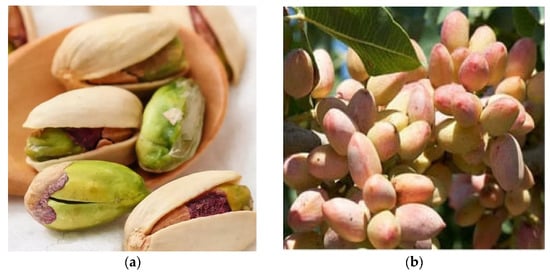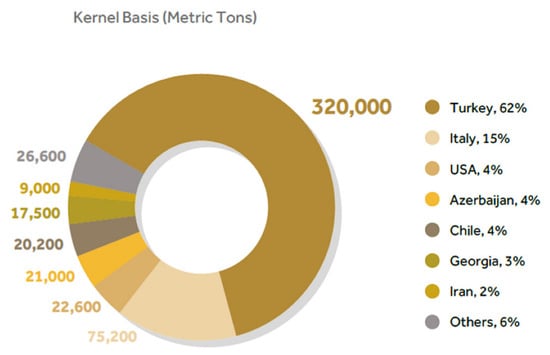You're using an outdated browser. Please upgrade to a modern browser for the best experience.
Please note this is an old version of this entry, which may differ significantly from the current revision.
Subjects:
Food Science & Technology
|
Nutrition & Dietetics
Nuts are dry, single-seeded fruits, with a combination of beneficial compounds that aid in disease prevention and treatment. Nuts’ skins are a good source of antioxidants thanks to the presence of polyphenolic compounds and other phytochemicals that can delay or inhibit lipid oxidation and neutralization of free radicals, contributing to disease prevention and treatments. Almond, hazelnut, pistachio are three very typical and common nuts.
- anti-inflammation
- antioxidant activity
- chronic disease
- diabetes
- fruit
1. Introduction
Nuts are used to describe dry, single-seeded fruits growing on trees. They are generally composed of leaf, green leafy cover, hull, hard shell, and skin. They are nutrient-dense foods, widely consumed as components of healthy diets worldwide and in both raw and processed forms [1].
There are many types of edible tree nuts such as almonds (Prunus amigdalis), hazelnuts (Corylus avellana), walnuts (Juglans regia), pistachios (Pistachia vera), pine nuts (Pinus pinea), cashews (Anacardium occidentale), pecans (Carya illinoiensis), macadamias (Macadamia integrifolia), and Brazil nuts (Bertholletia excelsa). Peanuts (Arachis hypogea) are botanically groundnuts or legumes, but are identified as part of the nut food group from a consumer’s perspective. Moreover, chestnuts (Castanea sativa) are considered nuts, although they differ from common nuts in terms of nutrient profile, having a higher starch content than others [2].
Tree nuts’ production worldwide varies according to a recent statistic from the International Nut and Dried Fruits Council (INC) showing the evolution of the world’s production of different nuts. For instance, the United States (US) is the leading country for almond production (79%), followed by both Australia and Spain (7%). Moreover, China is the world’s biggest walnut producer (47%) followed by the United States and Chile, at 31% and 7%, respectively. Australia and Western Africa are considered the leading countries for producing macadamias (25%), followed by China (14%) [3].
In Western countries, individuals consume whole nuts (fresh or roasted) as a snack, in desserts, or as part of a meal. Additionally, nuts oils are added as a versatile food ingredient to commercial products including sauces, pastries, ice creams, and baked goods. The consumption of nuts has increased in recent years because they are considered as a good energy source and beneficial to include in the daily diet. Nuts have an optimal nutritional density regarding healthy minerals and contain high amounts of vegetable protein and fat, especially unsaturated fatty acids (UFAs) [4]. Nuts also contain various nutrients and provide dietary fibers, vitamins, minerals, and other bioactive compounds [5].
Nuts’ skins are a good source of antioxidants thanks to the presence of polyphenolic compounds and other phytochemicals that can delay or inhibit lipid oxidation and neutralization of free radicals, contributing to disease prevention and treatments [1]. Antioxidant activity (AO) can be detected by several chemical or biological methods such as ferric reducing antioxidant power (FRAP) assay, 2,2-diphenyl-1-picrylhydrazyl (DPPH) radical scavenging activity, and 2,2′-azino-bis 3-ethylbenzothiazoline-6-sulphonic acid (ABTS) [1]. Naturally, antioxidants are nutrient and non-nutrient (phytochemicals) compounds with various types and properties. Nutrient antioxidants possess a weak AO (e.g., vitamin A, vitamin C, and selenium). Regarding non-nutrient antioxidants, they are considered much stronger in their activity, especially phenolic compounds [5].
2. Characteristics and Compositions of Pistachio Nut and Skin
Pistachio nut (Pistacia vera) is one of the world’s most popular tree nuts, belonging to the Anacardiaceae family, which comprises about 70 genera and over 600 species. P. vera is considered the only species of the genus commercially cultivated, while the other species are mostly used as rootstocks [6]. The pistachio fruits are drupe and grape-like clusters, containing a single seed covered with a soft and thin seed coat (skin/testa), the edible part (Figure 1a). The seed is covered with an inedible, smooth, hard, and cream-colored shell, which is alternatively covered by a thin and pale green colored hull, forming a blush of red color during maturity (Figure 1b) [7]. Production of pistachios is highly concentrated in the United States, with a percentage of 47% in comparison with other countries such as Turkey (30%) and Iran (19%) according to the INC 2021 statistics [3].

Figure 1. Pistacia vera L. open hard shell showing the red-purple skin (a); pistachio ripe fruit (hull) (b) [7].
Pistachio skin (testa) is the soft, thin, and edible seed coat that appears in red-purple. It is the main by-product, reaching more than 60%, with Iran producing around 400,000 tons of pistachio skin annually. Furthermore, various processing methods such as roasting and bleaching can cause destruction of bioactive compounds in pistachio skins [8].
Pistachio skin has value; although limited, it can be used in appropriate methods by different industries and fields. Testa is a rich source of phenolic or antioxidant compounds such as flavonoids (e.g., myricetin), gallotannins, and other phenolic compounds. In addition, the skin is used to prepare natural polymers thanks to its cellulose content [8]. Furthermore, it can be used in food and food processing, cosmetics, and pharmaceutical industries [7,8]. Moreover, the presence of various beneficial bioactive compounds in pistachio skin makes them valuable to add to an individual’s daily diet, which can contribute to disease prevention, as many studies have reported [5,7].
3. Characteristics and Compositions of Almond Nut and Skin
Prunus dulcis or almonds are a stone fruit under the Rosaceae family, and their trees require sustainable irrigation practices for cultivation and development, specifically in arid and dry regions [9]. As previously stated, the United States is the world’s largest producer of almonds, surpassing 1.3 million metric tons (MT) according to the INC statistical yearbook 2020/21 [3]. Almond nut consists of five main parts including the outer cover or hull with a greenish appearance, the intermediate shell, the edible brown skin coating, and the seed or kernel produced after the full ripening cycle of the fruit (Figure 2) [9]. The almond’s hull is the heaviest part of the kernel with a total fresh weight of around 52%, affected by the variable ripening cycle that changes according to cultivation conditions [10].

Figure 2. Weight proportion of the main structural parts of almond fruit [9].
Almond skin serves as a protective layer for the kernel against microbial contamination and oxidation. It appears as a brown leathery coating and represents 4% of the total weight (Figure 2). It contains many beneficial phytochemicals properties, comprising between 70% and 100% of the total phenols in the whole almond fruit [9].
Moreover, compounds have synergistic effects when linked with vitamins C and E, protecting against low-density lipoprotein-cholesterol (LDL-C) oxidation and improving the AO. Furthermore, the skin contains different quantities of triterpenoids, especially betulinic acid, oleanoic acid, and ursolic acid, which have anti-inflammatory, anticancer, and antiviral activities against human immunodeficiency virus (HIV) [9].
Almond skins are used in various products, including as a base component in wheat flour and as coloring for altering biscuits color [11]. A recent study proposed using almond skin extract for patients with intestinal inflammatory diseases [12]. In addition, the skin is a great source of fiber that serves as a prebiotic, affecting the gut microbiome [13].
4. Characteristics and Compositions of Hazelnut and Its Skin
Hazelnuts (Corylus avellana L.) belong to the Betulaceae family and are one of the most famous types of nuts worldwide. They are ranked third in the global nut market, as its production reaches over 863,000 MT per year. The largest producer of hazelnuts is Turkey (60%), estimated at 320,000 MT in 2020/21 statistics (Figure 3) [3]. The hazelnut consists of the green shell, the hard shell, leaves, skin, and the edible kernel [14].

Figure 3. INC 2020/21 statistics for hazelnut production in kernel bases (metric tons) [3].
Hazelnuts are used in a wide range of applications with increased demands for them in the global markets. They are used mainly as a feedstock in the food industry, especially in the sweet sector such as chocolate bars, ice creams, dairy products, and coffee. Furthermore, it can be added to many other products, from cereals and bread to yogurts and salads [14]. Moreover, hazelnut oil is used in cosmetic, medicinal, massaging, and cooking products. Hazelnut also contains filbert, which is a flavouring compound added in per-fumes [15]. Recently, the use of hazelnuts in other fields has increased, where hazelnut oil is considered a source of biodiesel fuel, as its chemical content is approximately similar to natural oil [16].
Hazelnut skin is a by-product of the roasting process and contains 7.5% moisture, 8% protein, 14.5% fat, and 1.7% ash. Dietary fiber represents the most abundant constituent of hazelnut skin (67.7%), of which 57.7% is insoluble fiber [17]. Moreover, the skin has a good AO compared with other food items [18]. According to Özdemir et al., the total phenolic content expressed as mg gallic acid equivalents per gram (mg GAE/g) is 233 mg GAE/g in skin. The skin of hazelnuts is used as a coloring agent in foods because of its natural brown color [17]. Similarly, it is an ingredient in different processed foods, especially bakery and confectionery products [18]. Skins can be used as an enrichment ingredient to produce functional yogurt [19] and can be added in freshly made pasta, increasing the total fiber content and AO [20].
This entry is adapted from the peer-reviewed paper 10.3390/nutraceuticals2040023
This entry is offline, you can click here to edit this entry!
